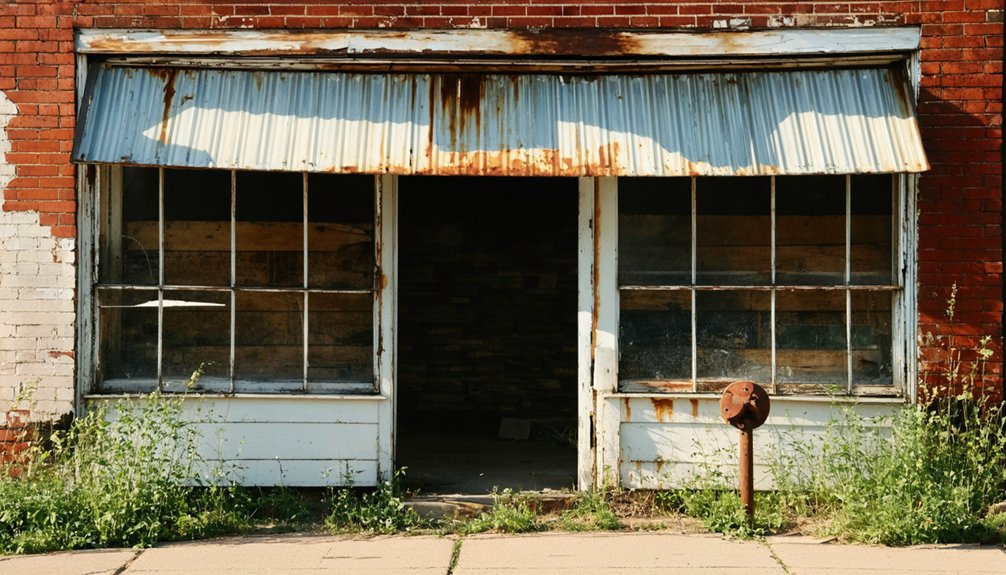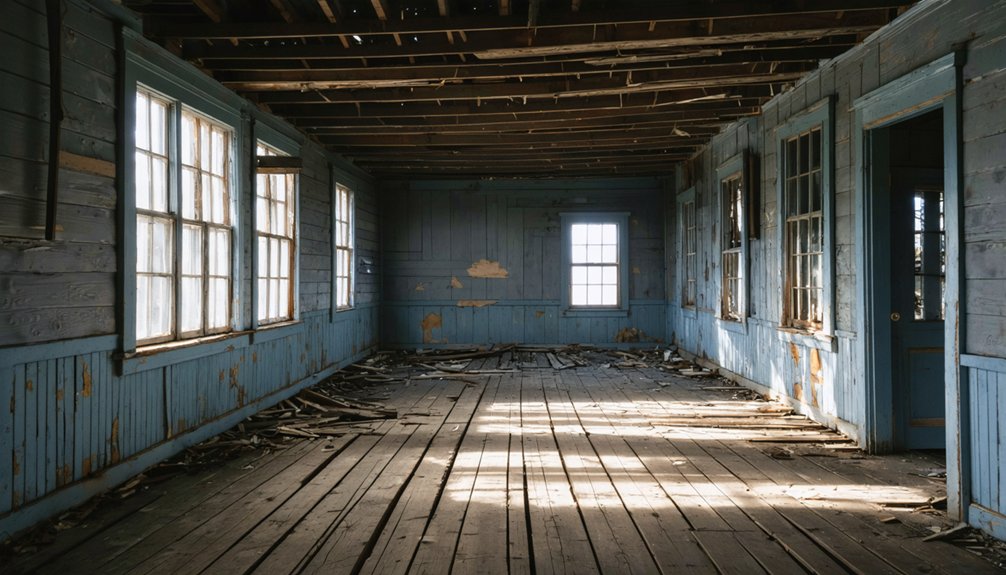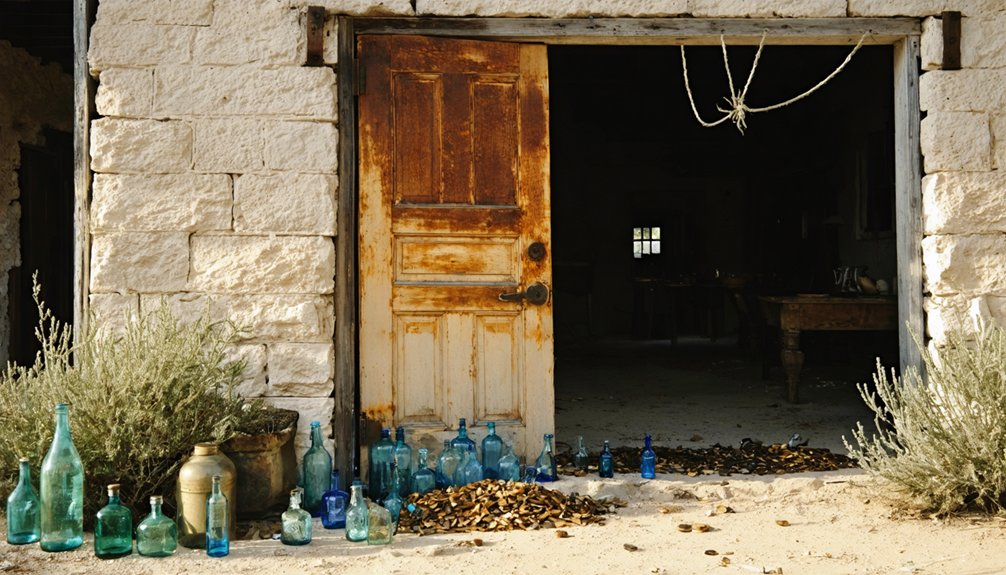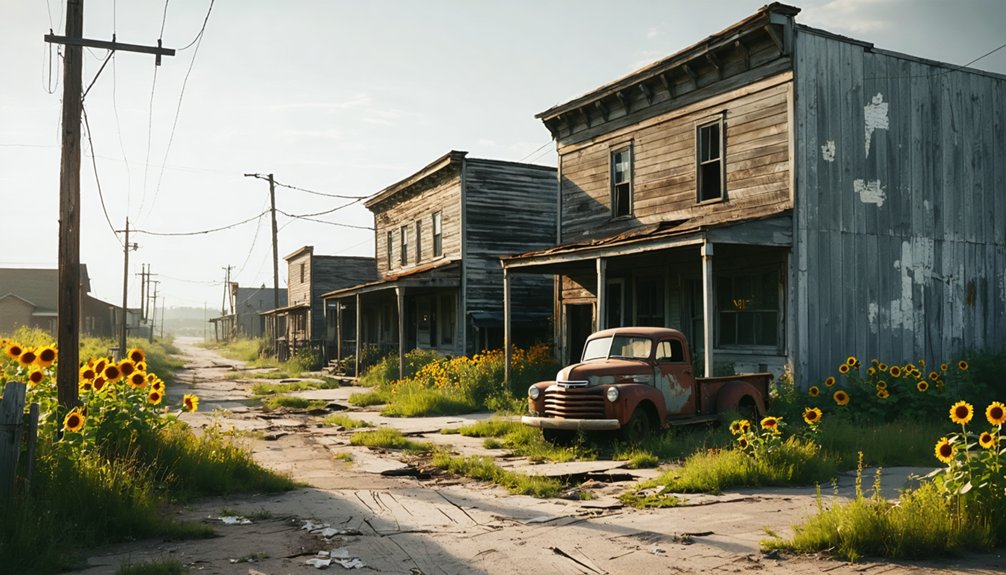You’ll find Bugtown among the Black Hills’ 600+ ghost towns, where it once thrived during the 1870s gold rush. The abandoned settlement features deteriorating wooden structures, including two former hotels and three general stores that served miners and their families. While the town declined after gold deposits were depleted and railroad service ended, you can still explore the historic ruins. The site’s archaeological discoveries and local legends paint a fascinating picture of frontier life.
Key Takeaways
- Bugtown is one of over 600 ghost towns in the Black Hills region of South Dakota, abandoned after the gold rush era.
- The town thrived during mining operations with three general stores, two hotels, and numerous wooden-frame homes serving the community.
- Economic decline began after gold deposits depleted in the 1870s, with railroad abandonment further isolating the settlement.
- The town was officially recognized as a ghost town by the 1920s and currently has zero population.
- Archaeological discoveries and preservation efforts continue, while the site attracts history enthusiasts and ghost town explorers.
Historical Origins and Early Settlement
While details about Bugtown‘s specific location remain scarce, this South Dakota ghost town emerged during a period when the Black Hills region saw the establishment of hundreds of similar settlements.
Like many of its counterparts, Bugtown’s settlement patterns likely followed the typical trajectory of Black Hills communities that sprung up during the area’s development.
Bugtown mirrored the rise and decline of countless Black Hills settlements, following a familiar path through South Dakota’s pioneering era.
The town’s community dynamics would have been shaped by the common factors that influenced settlement in the region, including mining opportunities and railroad access.
You’ll find that these early communities often started as small clusters of determined settlers who built their homes and businesses around specific economic purposes.
Ghost town tourism became a draw as petting zoos and shops were established to enhance the visitor experience.
The harsh winters and challenging conditions of South Dakota tested the resilience of these pioneer communities, contributing to their eventual transformation into ghost towns.
Similar to the more than six hundred ghost towns documented in the Black Hills area, Bugtown represents another example of pioneering ambition that ultimately faded into history.
Mining Operations and Economic Growth
Mining activities shaped the economic landscape of South Dakota’s Black Hills region, where operations like the legendary Homestake Mine drove development for over a century.
You’ll find that mining technology advancements transformed the area, as operations evolved from simple placer mining to sophisticated hard rock extraction using stamp mills and chlorination processes. The Jones and Pinney Mill pioneered these developments in 1876, setting the stage for more efficient gold recovery methods.
The Sioux Nation treaty of 1868 initially protected these lands from mining exploitation. The region’s prosperity rode waves of economic fluctuations tied to ore quality and gold prices. Towns like Lead grew alongside the mines, though they faced complex challenges over land and mineral rights.
Mining companies built essential infrastructure, including railroads and timber operations, while creating jobs that attracted settlers and spurred rapid urban development throughout the Black Hills.
Daily Life in Bugtown’s Heyday
You’d find Bugtown’s social fabric woven through its wooden-frame homes, where mining families gathered for evening storytelling and music sessions after long days at the mines.
Local commerce thrived along the town’s main thoroughfare, where merchants, blacksmiths, and saloon owners provided essential goods and services to the bustling community. Much like the railroad supply towns that emerged every seven miles across South Dakota, Bugtown developed to meet the needs of its hardworking residents. Similar to communities like Awanka, the town once boasted two thriving hotels to accommodate travelers and workers.
Despite the basic living conditions, with wood stoves for heat and shared water wells, residents established a vibrant community life complete with church services, school lessons, and regular social gatherings at the town hall.
Mining Families’ Social Activities
Life in Bugtown during its heyday centered around vibrant social gatherings that brought mining families together after long days underground. You’d find community traditions alive in the bustling community halls, where local musicians played while children danced and adults shared stories of frontier life.
Family gatherings often featured preserved foods and home-cooked meals that reflected the diverse ethnic backgrounds of Bugtown’s residents. The community’s health was supported by the modern hospital services provided at no cost to mining families. Many residents were part of generational mining culture that passed down traditions and skills from parent to child. The tight-knit community relied heavily on mutual support, with neighbors helping each other through hardships and celebrating milestones together.
During seasonal events and holidays, you’d see the whole town turn out for picnics, dances, and cultural festivals. Churches played a central role, hosting social events that strengthened bonds between families and preserved their shared mining heritage through storytelling and music.
Local Commerce and Trade
Three general stores anchored Bugtown’s bustling commercial district during its peak years, serving as essential hubs where miners and their families could purchase important supplies, collect mail, and exchange news.
These local businesses stocked everything from mining equipment to daily necessities, adapting their inventory to meet the community’s changing needs.
Trade routes connecting Bugtown to larger commercial centers relied initially on freight wagons and stagecoaches, bringing in crucial supplies like food, boots, and tools.
When the railroad arrived, it transformed the town’s commerce, enabling faster transportation of coal, lumber, and other goods.
The town’s merchants often combined multiple services under one roof – you’d find post office services and informal gathering spaces within the general stores, creating economic efficiency while fostering community connections.
Housing and Living Conditions
Beyond Bugtown’s commercial district, rows of simple wooden frame houses dotted the landscape, built hastily to shelter the influx of miners and their families during the boom years.
You’d have found basic housing materials like wood shingles or tin roofs protecting residents from harsh Black Hills weather, while local stone and brick were reserved for public buildings.
Living challenges included outhouses, wood-burning stoves for heat, and water hauled from nearby wells or streams. Similar to the residents of abandoned mining towns, these harsh conditions eventually led many families to seek opportunities elsewhere.
- Most homes were one or two rooms with minimal furnishings, reflecting frontier simplicity.
- Families often maintained small gardens and relied on hunting to supplement food supplies.
- Single miners typically shared crowded boarding houses with other workers.
- Winter survival demanded community cooperation and resourcefulness, especially during isolation.
Notable Buildings and Architecture

Bugtown’s architectural legacy reveals a typical early 20th-century frontier settlement, with buildings constructed primarily from local timber and brick.
The town’s most distinctive architectural features include the weathered wooden grain elevator, which despite its partially collapsed top, remains a dominant landmark along the rail line. You’ll find remnants of two-story brick commercial buildings lining what was once the bustling main street, their plain facades evidence to their utilitarian purpose. The stark black and white beauty of these decaying structures has been captured by fine art photographer Keith Dotson.
Like many sites in disrepair, the structures slowly deteriorate as nature reclaims the abandoned town.
The town’s modest wooden churches showcase simple Gothic Revival elements, including pointed arch windows and basic steeples.
The building materials reflect the practical needs of frontier settlers, from the locally sourced timber used in residential structures to the more permanent brick construction of banks and stores.
Even the small jail and town hall maintain their rectangular forms, though they’ve long stood empty.
Decline and Abandonment Timeline
The steady decline of this Black Hills settlement followed four distinct phases, beginning with the post-gold rush slowdown of the 1870s.
The Black Hills mining town’s descent into abandonment unfolded gradually, marking distinct stages after the 1870s gold rush faded.
Economic factors hit hard as richer gold discoveries elsewhere lured miners away, while population shifts dramatically reduced Bugtown’s numbers from their peak.
By the early 1900s, large-scale mining operations had replaced individual prospectors, further accelerating the town’s evolution.
- Initial exodus occurred as easily accessible gold deposits became depleted
- Introduction of industrial dredging technology in the early 1900s provided only temporary relief
- Railroad abandonment by mid-20th century isolated the settlement from crucial supply routes
- Final change to ghost town status happened by the late 20th century, when tourism replaced mining
Preservation Efforts and Current Status

Despite attempts to establish a living ghost town museum in Bugtown, preservation efforts have largely collapsed due to ownership challenges and the $799,000 asking price for the property in 2011.
You’ll find most original structures still standing but in deteriorated condition, with no active protection measures or stabilization projects currently in place.
The site’s remote location near the Badlands and lack of formal visitor infrastructure have limited both public awareness and institutional support for preservation initiatives.
Site Protection Measures
Similar to many historic ghost towns across South Dakota, preservation efforts at Bugtown reflect a complex mix of public and private initiatives aimed at protecting this cultural heritage site.
You’ll find access restrictions and preservation challenges managed through coordinated efforts between local authorities, historical societies, and dedicated volunteers. The site employs strategic protection measures to safeguard its remaining structures and artifacts while balancing public access with conservation needs.
- Physical barriers and warning signs mark sensitive areas to prevent unauthorized entry and vandalism
- Local volunteer groups conduct regular patrols and report suspicious activities to law enforcement
- Educational signage provides historical context while promoting responsible site visitation
- Environmental management practices, including erosion control and vegetation management, help preserve the site’s structural integrity
Structural Stabilization Projects
Following extensive engineering assessments in 2018, Bugtown’s structural stabilization projects have focused on preserving its most vulnerable historic buildings through targeted interventions.
You’ll find that local firms like Albertson Engineering have implemented preservation techniques specifically adapted to South Dakota’s harsh climate, ensuring the structural integrity of remaining structures against snow loads and high winds.
The stabilization work incorporates galvanized steel supports and compatible mortar repairs, while maintaining historical authenticity.
Crews have installed corrugated steel reinforcements and conducted essential foundation work to prevent further settling. These projects unfold in careful phases, beginning with temporary shoring before permanent solutions are applied.
The work prioritizes reversible interventions and historically sympathetic materials, protecting Bugtown’s heritage while strengthening its aging buildings for future generations.
Tourism and Visitor Guidelines
While Bugtown stands as one of South Dakota’s atmospheric ghost towns, visitors must follow specific guidelines to guarantee both their safety and the site’s preservation.
Bugtown’s haunting ruins offer a window into South Dakota’s past, but responsible tourism ensures its stories endure for future generations.
You’ll want to plan your route carefully, as the remote location can challenge GPS navigation. Tourist safety depends on respecting structural hazards and staying clear of unstable buildings, while visitor etiquette requires leaving artifacts untouched and respecting private property boundaries.
- Check weather conditions and road accessibility before departing, especially during winter months
- Park considerately without blocking local access roads or farm paths
- Bring maps and historical guides, as official signage is minimal
- Consider joining organized tours through local historical societies for enhanced experiences
Archaeological Discoveries and Artifacts

Archaeological excavations at Bugtown have yielded a fascinating array of artifacts that illuminate daily life in this frontier settlement. You’ll find evidence of frontier capitalism sparked by Black Hills gold discoveries, revealed through archaeological techniques that have uncovered fallen brick chimneys and concentrated cultural deposits.
Excavators have documented diverse leisure activities through recovered coins, dice, poker chips, and Chinese gaming pieces.
The artifact significance extends to privy sites near boardinghouses, where temporal deposits enable reconstruction of dietary habits and material culture. You can trace cultural interactions through discovered opium-smoking paraphernalia and Chinese gaming pieces, while fragmented dishware and botanical remains paint a picture of daily life.
These findings showcase how Bugtown’s inhabitants adapted to frontier life while maintaining connections to various cultural practices and traditions.
Local Legends and Historical Records
As miners flocked to the Black Hills during the late 19th century gold rush, Bugtown emerged among the region’s numerous boomtown settlements, leaving behind a rich tapestry of local legends and historical records.
You’ll find the legends’ origins woven into tales of determined prospectors, dangerous mining ventures, and ghostly encounters that still captivate visitors today.
While historical documents confirm Bugtown’s establishment through maps, newspapers, and mining registries, the town’s exact location remains debated due to inconsistent record-keeping.
- Tales speak of saloons and boarding houses serving weary miners seeking their fortunes.
- Stories recount mysterious disappearances linked to treacherous mining conditions.
- Oral histories describe resilient families maintaining businesses despite harsh winters.
- Local lore includes accounts of supernatural occurrences in abandoned structures and graveyards.
Frequently Asked Questions
Are There Any Paranormal Activities or Ghost Sightings Reported in Bugtown?
You won’t find documented ghost encounters or haunting legends in this location. While South Dakota’s ghost towns often have paranormal claims, there’s no credible evidence of supernatural activity here.
What Native American Tribes Originally Inhabited the Bugtown Area?
Like ancient footprints in sacred soil, the Sioux nation – particularly Lakota and Dakota peoples – were your land’s first stewards, dominating the region through their hunting grounds and settlements.
How Did Bugtown Get Its Unusual Name?
You’ll find Bugtown’s name origin remains somewhat mysterious, but it likely came from early mining settlers who noticed abundant insects in the area during the Black Hills gold rush period.
What Wildlife Species Can Visitors Commonly Encounter Around Bugtown Today?
Want to spot amazing wildlife? You’ll find abundant wildlife sightings around Bugtown’s prairies, including bison herds, pronghorn antelope, white-tailed deer, prairie dogs, and bald eagles – perfect for nature photography enthusiasts.
Did Any Famous Outlaws or Historical Figures Ever Visit Bugtown?
You won’t find documented proof of historical visits by famous outlaws to this location, though regional outlaw legends abound in South Dakota’s ghost towns during the late 1800s mining era.
References
- https://www.sdpb.org/rural-life-and-history/2023-08-21/some-black-hills-ghost-towns-and-their-origins
- https://www.youtube.com/watch?v=Glucs_Rq8Xs
- https://www.powderhouselodge.com/black-hills-attractions/fun-attractions/ghost-towns-of-western-south-dakota/
- https://www.youtube.com/watch?v=_0WNYsFLSLA
- https://www.blackhillsbadlands.com/blog/post/old-west-legends-mines-ghost-towns-route-reimagined/
- https://icatchshadows.com/okaton-and-cottonwood-a-photographic-visit-to-two-south-dakota-ghost-towns/
- https://en.wikipedia.org/wiki/List_of_ghost_towns_in_South_Dakota
- https://openprairie.sdstate.edu/etd/4061/
- https://aberdeenmag.com/2019/01/the-ghost-towns-of-brown-county/
- https://www.sdhspress.com/journal/south-dakota-history-2-2/some-black-hills-ghost-towns-and-their-origins/vol-02-no-2-some-black-hills-ghost-towns-and-their-origins.pdf



